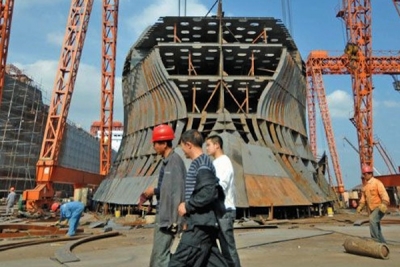The good and bad outlook for Chinese shipbuilding

The year 2015 rounded out with not much good news for China’s shipbuilding sector, which is gripped by a protracted slowdown since the onset of the 2008 global financial crisis. How will the Chinese shipbuilding market fare in 2016? Maybe both good and bad.
The bad news is that more Chinese shipyards, in particular privately-owned enterprises, are expected to go bankrupt or shut down due to debts or simply having no new orders to sustain operations.
With more than 3,000 shipbuilding enterprises, mostly speculative yards, counted at the start of 2010, that number has drastically dwindled to only around 300 today, and only a little more than 100 yards have active day-to-day operations.
Ren Yuanlin, executive chairman of Yangzijiang Shipbuilding, which remains profitable despite the challenging market, has predicted that China will eventually be left with 20 to 30 shipbuilding companies after the severe consolidation period for the industry is over, and it could still be a few years away.
China’s shipbuilding statistics reveal an ominous sign that Ren could be right. In the first 11 months of 2015, China Association of the National Shipbuilding Industry (Cansi) reported that 54 of the country’s leading shipyards received 92.5% market share the country’s newbuilding tonnage, meaning that easily a few hundred other yards from among the estimated 300 have gotten zero new orders for the entire year.
Last year alone, Seatrade Maritime News reported that four Chinese shipyards filed for restructuring, namely Jiangsu Eastern Heavy Industries (JEHI), Zhejiang Judger Shipbuilding, Wenzhou Yuandong Shipyard, and Zhenghe Shipbuilding. In addition, Nantong Mingde Heavy Industry and government-backed Wuzhou Shipyard were declared bankrupt, STX Dalian Shipbuilding was liquidated, and Rongsheng Heavy Industries now renamed China Huarong Energy is hanging on by a thread from bankruptcy.
Another yard Sainty Marine is also on the verge of bankruptcy, and only a miracle could save it going by its problems of order cancellations, frozen bank accounts, resignation of key executives, lawsuits, unpaid debts, and suspension of shares trading.
The outlook for China’s shipbuilders is further shadowed by the Baltic Dry Index (BDI) consistently setting new lows since the start of this year. And with bulk carriers accounting for 41.6% of Chinese shipyards’ $26.6bn orderbook as of 1 December 2015, according to Clarkson’s data, their exposure to this particularly weak shipping sector will have a negative knock-on effect.
But what of the good news? With industry observers always citing that shipping, including shipbuilding, is a cyclical market, the upturn for China’s shipbuilders when it eventually comes, is anticipated to see a reformed, leaner and more competitive shipbuilding industry.
China’s state-owned shipbuilders and China State Shipbuilding Corporation (CSSC), for instance, have responded to the declining new orders by consolidating its various yard subsidiaries so as to streamline operations and maximise facility utilisation.
With state-owned corporations undergoing reform to tighten operations and the weeding out of speculative yards and the bottom-rung private enterprises, the survival of the handful of shipyards is not by chance.
Owners, who are themselves cash-strapped and cautious with placing new orders, are not about to approach unknown and less reputable yards to construct their new ships, and they would also require the vessels to be more technologically advanced and energy efficient. This goes back to answer why more than 90% of new orders are concentrated in the handful of supposedly better Chinese yards.
It is easy to see the obvious woes for Chinese shipyards, but there is always two sides to a story. And when the unforgiving consolidation is over possibly leaving less than 30 shipyards in China, the country could well be a shipbuilding powerhouse boasting of price competitiveness and quality.
HEADLINES
- Do shipping markets want Biden or Trump for the win?
- All 18 crew safe after fire on Japanese-owned tanker off Singapore
- Singapore launching $44m co-investment initiative for maritime tech start-ups
- Cosco debuts Global Shipping Industry Chain Cooperation Initiative
- US warns of more shipping sanctions
- China continues seaport consolidation as Dalian offer goes unconditional